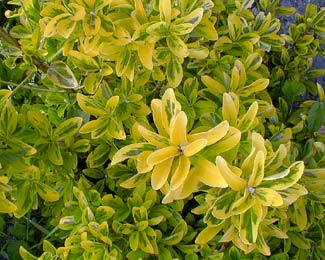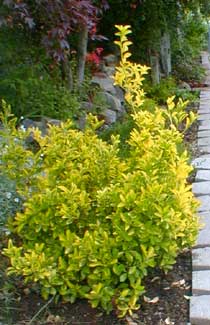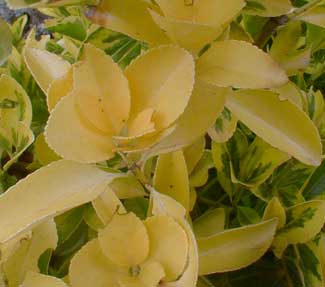
Golden Euonymus,
Variegated Japanese Yew, or
Gold-edged Evergreen Spindle-tree
"Art thou poor, yet hast thou golden slumbers?
O sweet content!"
-Thomas Dekker
(1572-1632)
(1572-1632)
Back when we bought the house & were first putting in lots of shrubs, I from the start wanted to insure winter interest to the gardens. An evergreen with bright yellow throughout the leaves was a promise of year-round color.
 Almost immediately upon planting it, I felt that it was a bit much, & doubted I should have installed quite such a gaudy shrub. It's out-of-place impact pretty much cured me of interest in such overtly yellow-leafed shrubbery.
Almost immediately upon planting it, I felt that it was a bit much, & doubted I should have installed quite such a gaudy shrub. It's out-of-place impact pretty much cured me of interest in such overtly yellow-leafed shrubbery.Yet visitors frequently are attracted to it, & I've gotten increased satisfaction from it as it slowly gains height, & as other plants encroach upon it so that it no longer has to stand alone.
The plusses for Euonymous japonica are many. It is fully evergreen & colorful for year-round impact. Its leaf density makes it hedgeable (though for my own tastes any shrub that is poodled or hedged looks mistreated). It adapts to any reasonable soil condition.
 Furthermore, it is salt-tolerant for maritime coastal settings. It is very cold-hardy, though it can sometimes suffer in full sun when grown in the south.
Furthermore, it is salt-tolerant for maritime coastal settings. It is very cold-hardy, though it can sometimes suffer in full sun when grown in the south.It can even be grown as a houseplant, or brought indoors for the winter if grown as a potted patio plant further north.
On Puget Sound it is drought-hardy in full sun, yet does just as well in wet ground or in partial shade. We planted ours at a corner edge of the property which gets very little watering, & it does just fine.
There are a few things to weigh on the negative side. Greenish-white late spring or early summer panicles of tiny flowers are not significant, & certainly can't compete with the brightly yellow-edged leaves. The fruits are also inconspicuous on 'Aureo-marginata' though for the regular green form red fruit in autumn can be showy.
The literature on this shrub warns its leathery leaves can be susceptible to powdery mildew, & it should be treated for fungus as regularly as are roses. Despite this warning, ours has never had the least problem even while being completely unattended, leading me to suppose powdery mildew is more of a problem for it in hotter zones where it would be stressed, or in high-humidity conditions with poor air circulation. "Knock on woody shrubs," we've never seen the least bit of mildew on it.
This native of southern Japan has many cultivars from dwarf to very large. 'Aureo-marginata' is one of the larger varieties, reaching five to seven feet in five years, then slowing down considerably but potentially becoming twelve feet. It has upright stance, spreading four or five feet wide. It is ammenable to pruning to achieve specific sizes or effects.